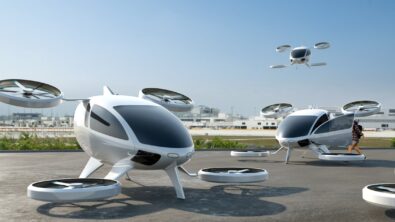Will autonomous driving bring an end to car ownership?

Autonomous driving is changing how automakers think about the way they design and engineer cars. These cars of the future likely won’t resemble what we know today. They may look more like mobile living rooms made of lightweight, composite materials instead of the more traditional materials we see now. And if mobility becomes a service, which is highly likely, these autonomous cars may even spell the end of car ownership.
Planning for these potential changes comes with a host of challenges, technological and societal. But there are visionaries ready to take on these challenges.
I spoke with one such visionary, Gernot Spiegelberg, the head of electro-mobility in the corporate technology division of Siemens AG, about what’s happening with autonomous cars and how mobility as a service could transform cars and cityscapes as we know them.
Spiegelberg is no stranger to bringing change in the auto industry. He began his career at Daimler-Chrysler, where he was responsible for the global pre-development of mechatronic systems. During his 18 years there, he helped develop drive-by-wire cars and autonomous driving in large trucks.
When he began with Siemens, Spiegelberg worked with the corporate management board to launch electro-mobility in the company. His current role involves using a new system architecture to integrate software and electronics into cars so they can fulfill the requirements of autonomous driving. Spiegelberg began our conversation discussing his role in this process.
Gernot Spiegelberg: What I do today, because I know how such an agent should look like, I have to fulfill the requirements of how a car can work in a future service we call “mobility as a service” driven by a mobility provider.
This mobility provider needs a connection over the cloud where the passengers can give their requirements for being transported, and the mobility provider will arrange this and send the autonomous agents to the passengers that the agent can transport.
It’s not only for passengers, it’s for goods as well. In the future, it won’t matter whether we transport people by cars on the road, by trains on the rail, by ships on the water or by airplanes in the air – we can combine all of this and call this “combined traffic.”
This is what I do now and what I’m working on.

 Mobility as a service could transform everything about the auto industry as we know it.
Mobility as a service could transform everything about the auto industry as we know it.
Ed Bernardon: It sounds like you have a very strong experience in automotive electronics, software, smart autonomous agents, definitely the foundation for where cars are going to go in the future. What do you think are going to be some of the major changes that we’ll see in automobiles and automotive systems, especially in the area of control and communication in the coming years?
Gernot Spiegelberg: There are three things [changing in parallel]. The first is driveline of the car. It will change from combustion engine-driven systems to electrical systems. This is the first. The second is, we will go from manual-driven cars to the functionality of autonomous-acting cars.
And, the last, I see a change in the behavior of society. Society will not, especially elderly people, as well as the younger generation, pay 100 percent for a car when they use the car only 10 percent over their lifetime. They run the car 10 percent, and the car stands still over [its] lifetime 90 percent.
And they won’t want to possess the car, furthermore. They want a service. They want to be transported by a good system. What I think will happen, especially in this part of the society, is they don’t want to have fun by driving. They want to have fun by being transported. This is a completely different thing.
 Will people still want to own a car if mobility as a service hits the market?
Will people still want to own a car if mobility as a service hits the market?
If you combine all of these together, the following, in my opinion, will happen. Autonomous driving will come into the run because it is the innovation path we are all, all over the world, driving toward. European car manufacturers are dealing with this, and autonomous driving will be there. It will be available, I think, in 2020 to 2022, and perhaps even earlier, because the run is going.
And it’s very important who will be the first, because they will be the leader in innovation of automotive technology. Everybody is fighting in this area.
But, what will happen with the cars, with autonomous driving? Mobility will exist, [but] there is no further need to possess a car because you can precisely, on the second, get your transportation on-demand. This will be prepared by the mobility provider, who will read your Outlook calendar, where your appointments are listed. They will listen and they will read this, and out of this data, they know when you have to be where and at what time.
With this, they can calculate how you get to those places in the best way. And then, they will provide you a service – being transported by the mobility provider with the best comfort, which will fit your personal profile.
And, based on this business, now the revolution will start. This revolution has an impact on the car manufacturers, because this mobility provider is now the contact to the customer. The customer is not a buyer of a car – this is a customer buying the service.
 If mobility as a service takes off, the mobility provider would take over as the primary contact for customers — not automakers.
If mobility as a service takes off, the mobility provider would take over as the primary contact for customers — not automakers.
Now, the mobility provider needs devices that, in this way, can best understand the passenger of the service – fancy services, convenient services, on one hand. On the other hand, he has to look after the cost of this. He has to look at the total cost of ownership. For this, he needs a low-cost device with maximum functionality, and this device has to have the lowest costs for maintenance and energy costs.
Based on these relations, he [the mobility provider] will buy only electrical cars. Combustion engine cars are too expensive and need too much maintenance, and [the provider] has a problem: this car, in the near future, will not be able to enter cities. Based on the emissions the car will bring, nobody will allow these cars to enter cities.
The last is, these providers need two fundamental things. They need the car, which is able to drive autonomously, and they need an infrastructure that makes the car able to run autonomously. What the mobility provider will do is, they will pay for both. They will finance both. They want to have the ability, for these devices, to earn money from mobility as a service as fast as possible.
This is what I think will happen. And I see a problem for the existing car manufacturer. They are now dealing with autonomous driving ability in existing cars, and they’ll invest a lot of money in this. But in the end, they will have cars that look like cars of today, but with the ability of autonomous driving.
But for the service of mobility – of mobility as a service – I guess these devices are not fulfilling, really, the requirements of the passengers who will want completely different comfort than what existing cars today bring.
—–
Earlier in this series, we discussed how ethical and technological issues must be addressed for autonomous cars to become a reality. Autonomous mobility as a service also adds the notion of societal change that could significantly impact our daily lives and many of the businesses around us. If we no longer own cars, and cars will no longer be parked but active at all times moving people and goods, a string of changes will be put in motion. Consider these potential changes:
• Cars will no longer be in personal garages, and homes could become more affordable without the added space for storing a personal car. Space not used for car storage will be put to different use.
• Services such as car washes, auto parts stores, auto repair and possibly even gas stations, will no longer be consumer businesses, but rather be part of a business-to-business economy targeting mobility providers. This could reduce the number of people employed in these service industries.
• Because dealerships no longer sell to consumers, there will be a reduced need to market cars. Just think: no car advertisements on a screen or in print. Instead, we could see more mobility service providers market and sell subscriptions to their service.
• Individual cars will accumulate mileage at a much greater rate, reducing their usable service life over time. Mobility providers will be pushed to improve cars’ service life and reduce “off-road” time for repairs. And as cars become more reliable, the need for repair services and technicians will decrease.
• Vehicles will rarely crash as autonomous operation removes the cause of most accidents, so the cost and need for accident insurance will be reduced. Business may offer mobility serves as a benefit rather than free parking or a company car.
• Trip costs will be significantly reduced, making travel and the distribution of goods more affordable while opening up personal and business financial resources for other uses.
• Otto, the driverless truck startup acquired by Uber, recently completed the first commercial delivery by a self-driving truck; its cargo was 2,000 cases of Budweiser beer. If such lower cost deliveries in the future could reduce the cost of beer to the consumer by just 1 percent, it would free over $1 billion dollars in financial assess for other purchases – or just increase beer drinking by 1 percent!
This is just a start to a list that is sure to grow.
This concludes part one of my interview with Gernot Spiegelberg. In the next part, we talk about how current city infrastructure could change if innovations with mobility as a service and autonomous driving continue on their current path.
Tell Us: Do you think autonomous driving and mobility as a service will lead to the end of the car ownership culture? Why or why not?
About the author
Edward Bernardon is vice president of strategic automotive initiatives for the Specialized Engineering Software business segment of Siemens PLM Software, a business unit of the Siemens Industry Automation Division. Bernardon joined the company when Siemens acquired Vistagy, Inc. in December, 2011. During his 17 year tenure with Vistagy, Bernardon assumed the roles of vice president of sales, and later business development for all specialized engineering software products. Prior to Vistagy, Bernardon directed the Automation and Design Technology Group at the Charles Stark Draper Laboratory, formerly the Massachusetts Institute of Technology (MIT) Instrumentation Laboratory, which developed new manufacturing processes, automated equipment and complementary design software tools. Bernardon received an engineering degree in mechanical engineering from Purdue University, and later received an M.S. from the Massachusetts Institute of Technology and an MBA from Butler University. He also holds numerous patents in the area of automated manufacturing systems, robotics and laser technologies.


